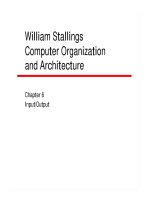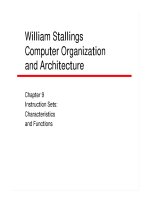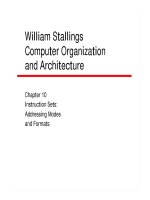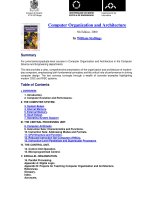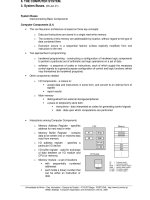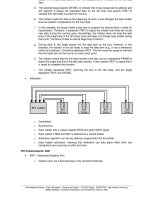Bài giảng Computer Organization and Architecture: Chapter 10
Bạn đang xem bản rút gọn của tài liệu. Xem và tải ngay bản đầy đủ của tài liệu tại đây (256.23 KB, 39 trang )
William Stallings
Computer Organization
and Architecture
6th Edition
Chapter 10
Instruction Sets:
Characteristics
and Functions
What is an instruction set?
• The complete collection of instructions that are
understood by a CPU
• Machine Code
• Binary
• Usually represented by assembly codes
Elements of an Instruction
• Operation code (Op code)
—Do this
• Source Operand reference
—To this
• Result Operand reference
—Put the answer here
• Next Instruction Reference
—When you have done that, do this...
Where have all the Operands gone?
•
•
•
•
•
Long time passing….
(If you don’t understand, you’re too young!)
Main memory (or virtual memory or cache)
CPU register
I/O device
Instruction Cycle State Diagram
Instruction Representation
• In machine code each instruction has a unique
bit pattern
• For human consumption (well, programmers
anyway) a symbolic representation is used
—e.g. ADD, SUB, LOAD
• Operands can also be represented in this way
—ADD A,B
Simple Instruction Format
Instruction Types
•
•
•
•
Data processing
Data storage (main memory)
Data movement (I/O)
Program flow control
Number of Addresses (a)
• 3 addresses
—Operand 1, Operand 2, Result
—a = b + c;
—May be a forth next instruction (usually implicit)
—Not common
—Needs very long words to hold everything
Number of Addresses (b)
• 2 addresses
—One address doubles as operand and result
—a = a + b
—Reduces length of instruction
—Requires some extra work
– Temporary storage to hold some results
Number of Addresses (c)
• 1 address
—Implicit second address
—Usually a register (accumulator)
—Common on early machines
Number of Addresses (d)
• 0 (zero) addresses
—All addresses implicit
—Uses a stack
—e.g. push a
— push b
— add
— pop c
—c = a + b
How Many Addresses
• More addresses
—More complex (powerful?) instructions
—More registers
– Interregister operations are quicker
—Fewer instructions per program
• Fewer addresses
—Less complex (powerful?) instructions
—More instructions per program
—Faster fetch/execution of instructions
Design Decisions (1)
• Operation repertoire
—How many ops?
—What can they do?
—How complex are they?
• Data types
• Instruction formats
—Length of op code field
—Number of addresses
Design Decisions (2)
• Registers
—Number of CPU registers available
—Which operations can be performed on which
registers?
• Addressing modes (later…)
• RISC v CISC
Types of Operand
• Addresses
• Numbers
—Integer/floating point
• Characters
—ASCII etc.
• Logical Data
—Bits or flags
•
(Aside: Is there any difference between numbers and characters?
Ask a C programmer!)
Pentium Data Types
•
•
•
•
•
•
8 bit Byte
16 bit word
32 bit double word
64 bit quad word
Addressing is by 8 bit unit
A 32 bit double word is read at addresses
divisible by 4
Specific Data Types
•
•
•
•
•
•
•
•
•
General arbitrary binary contents
Integer single binary value
Ordinal unsigned integer
Unpacked BCD One digit per byte
Packed BCD 2 BCD digits per byte
Near Pointer 32 bit offset within segment
Bit field
Byte String
Floating Point
Pentium Floating Point Data Types
PowerPC Data Types
• 8 (byte), 16 (halfword), 32 (word) and 64
(doubleword) length data types
• Some instructions need operand aligned on 32
bit boundary
• Can be big or littleendian
• Fixed point processor recognises:
—Unsigned byte, unsigned halfword, signed halfword,
unsigned word, signed word, unsigned doubleword,
byte string (<128 bytes)
• Floating point
—IEEE 754
—Single or double precision
Types of Operation
•
•
•
•
•
•
•
Data Transfer
Arithmetic
Logical
Conversion
I/O
System Control
Transfer of Control
Data Transfer
• Specify
—Source
—Destination
—Amount of data
• May be different instructions for different
movements
—e.g. IBM 370
• Or one instruction and different addresses
—e.g. VAX
Arithmetic
•
•
•
•
Add, Subtract, Multiply, Divide
Signed Integer
Floating point ?
May include
—Increment (a++)
—Decrement (a)
—Negate (a)
Shift and Rotate Operations
Logical
• Bitwise operations
• AND, OR, NOT

